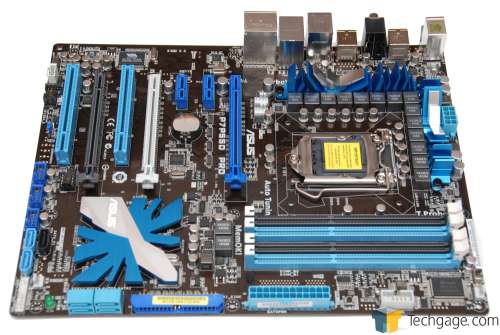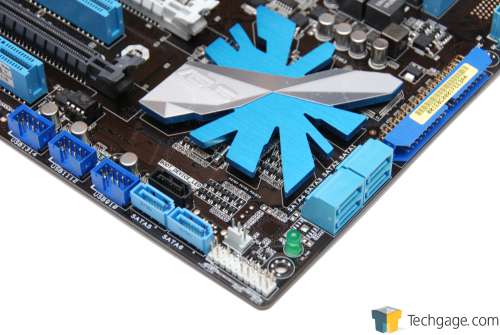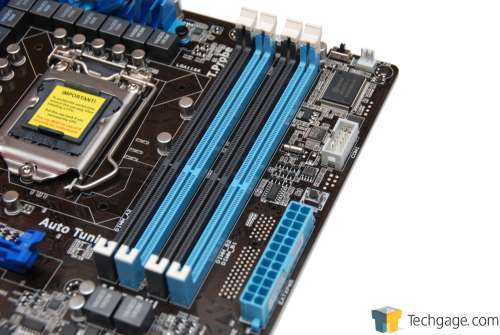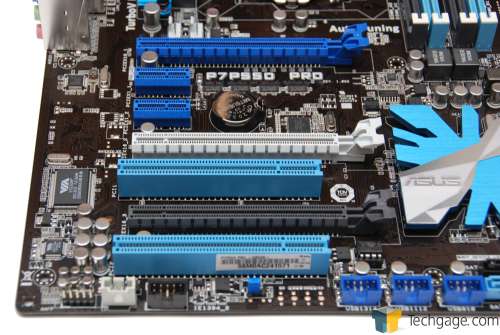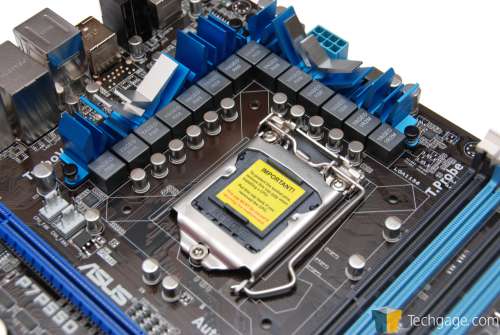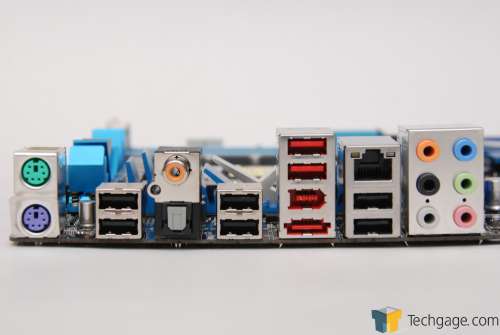- Qualcomm Launches Snapdragon 4 Gen 2 Mobile Platform
- AMD Launches Ryzen PRO 7000 Series Mobile & Desktop Platform
- Intel Launches Sleek Single-Slot Arc Pro A60 Workstation Graphics Card
- NVIDIA Announces Latest Ada Lovelace Additions: GeForce RTX 4060 Ti & RTX 4060
- Maxon Redshift With AMD Radeon GPU Rendering Support Now Available
ASUS P7P55D Pro Preview
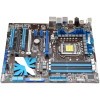
In preparation for Intel’s upcoming Lynnfield processors, we took a look at Gigabyte’s P55-UD5 last week, and this week, ASUS’ P7P55D Pro is on our workbench for a quick once-over. Equipped with lots of functionality, an easy-to-stomach price and a great color scheme, this board should prove to be a popular choice upon its launch.
Last Friday, we posted a preview of one of the many boards that Gigabyte will be launching alongside Intel’s Lynnfield processors next week, but that company is hardly the only one that will have quite the selection of boards available. ASUS is another, with no less than nine LGA1156 offerings, six of which fall under the P7P55D branding.
Like all previous launches from ASUS, there are boards to satisfy virtually any price-range, beginning at $139 with the LE model. The Pro which we’ll be looking at today falls about just in the middle of the pack, and will sell for around $179. By comparison, the highest-end P7P55D, the Premium, will retail for $279. Most of that price is due to extra features tacked on, such as a 32-phase solution.
There are a few features that almost all of ASUS’ P7P55D boards offer that ASUS wants everyone to know about. The first is TurboV EVO, a hardware-based overclocking feature that assists those who want impressive overclocks without putting in days of work. There’s also T. Probe, a technology that accurately distributes the load across all of the available phases, for ultimate efficiency and improved temperatures.
Have you ever installed a kit of RAM, only to have your PC not boot with it installed? ASUS’ Mem OK feature is designed to aide in this situation. At boot, if the RAM kit has SPD profile issues, the BIOS will force stable settings in order to allow you to change them. There are other features as well, such as their Q-Connector, Q-Shield and EPU, but we’ll leave talking about those and the others until our final review is posted in a few weeks.
ASUS’ P7P55D Pro
As mentioned above, ASUS has nine boards to launch alongside Intel’s Lynnfield processors, six of which fall under the P7P55D family. The others include two Maximus boards (one suited for mATX use) and Sabretooth, a model to fall under the company’s “The Ultimate Force” series – one that we don’t currently know too much about. Suggested prices are as follows:
- ASUS’ P55 Launch Lineup
- P7P55D LE: $139
- P7P55D: $155
- P7P55D Pro: $179
- P7P55D EVO: $199
- P7P55D Deluxe: $229
- P7P55D Premium: $279
- Maximus III Formula: $259
- Maximus III Gene: $209
- Sabertooth P55: $219
As you can see, the Pro version settles in at $179, also known as a price that most people can actually afford. Despite three models being placed above it, the Pro lacks very little. Compared specifically to the higher-end models, the Pro is missing a TurboV Remote (hardware-based overclocking), Drive Xpert (RAID feature) and also Stack Cool3+ (added copper to the PCB).
So let’s take a look at the board!
The first thing I noticed after taking the board out of the box is simple… the color. I’m a big fan of blue, so ASUS really appeals to my eyes with the P7P55D series. There are also a few improvements around the board that are worth noting, such as the unique end tabs on the PCI-E 16x slots, which makes it even easier to remove a GPU, and also the lack of bottom tabs on the DIMM slots, which again, makes it easier to both install and uninstall your RAM.
If there’s one limitation of the Pro compared to the Deluxe and Premium, it’s that it includes only 7 S-ATA ports (compared to 8 and 9, respectively). Of these, four are vertically-mounted, so absolutely no GPU will be able to screw your install over. I would have preferred to have seen all seven available this way, but the other three are found at the bottom, so they are at least out of the way and shouldn’t cause any issues.
After dealing with Nehalem for so long, and its triple-channel memory controller, I almost began to forget what dual-channel looked like, but here it is. I love the DIMM slot design, with the lack of lower tabs, and also the color (personal preference).
Of the available slots, three are PCI-E 16x, suitable for your single or triple GPU configurations (slots will become 8x for dual cards and 8x/8x/4x for triple). Also found are two PCI-E 1x slots and also two legacy PCI slots.
A few years ago, a power phase solution like the one seen below would have been considered crazy. Today, it’s considered mild. Some of ASUS’ and Gigabyte’s higher-end boards feature 32 phases, but that’s overkill in every sense of the word. The 12+2 solution here is going to prove more than sufficient for the vast majority of enthusiasts and overclockers. Even for extreme OC’ing, the value of 12+ phases is going to be debated.
Taking a look at the back I/O panel, we can see nothing lacking. Available are two PS/2 legacy peripheral ports, eight USB, a FireWire, eSATA, LAN and audio ports.
That about wraps up our quick look. We’ll of course offer a lot more information on this board once our final review hits, including information related to the BIOS and overclocking. I have to say I like what I see from ASUS with this one. There are a few trade-offs made here, but nothing major. The color scheme is sweet, and so is the feature-set. If the overclocking matches up, at $179, this board may very well prove to be a perfect choice for your new Lynnfield CPU.
Discuss this article in our forums!
Have a comment you wish to make on this article? Recommendations? Criticism? Feel free to head over to our related thread and put your words to our virtual paper! There is no requirement to register in order to respond to these threads, but it sure doesn’t hurt!
Support our efforts! With ad revenue at an all-time low for written websites, we're relying more than ever on reader support to help us continue putting so much effort into this type of content. You can support us by becoming a Patron, or by using our Amazon shopping affiliate links listed through our articles. Thanks for your support!




